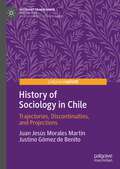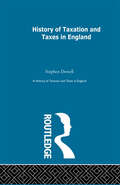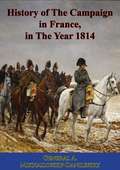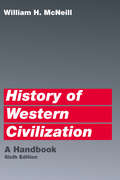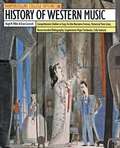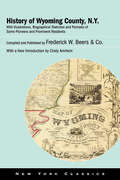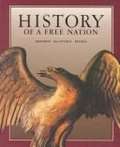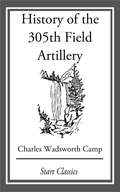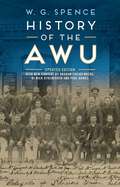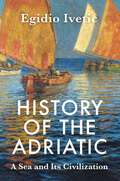- Table View
- List View
History of Science: A Beginner's Guide (Beginner's Guides)
by Sean F. JohnstonEmploying intellectual history, philosophy, and social studies, Sean Johnston offers a unique appraisal of the history of science and the nature of the evolving discipline. Science is all-encompassing and contentious. Based on its past, where might it lead in the twenty-first century? Sean F. Johnston is a reader in the History of Science and Technology at the University of Glasgow.
History of Sindhi Literature
by L. H. AjwaniIt is the first attempt, in the English language, to give a simple and connected narrative of literature in the Sindhi language.
History of Social Law in Germany
by Michael StolleisThe sole available comprehensive history of social law and the model of social welfare in Germany. The book explains the origins since the medieval times, but concentrates on the 19th and 20th centuries, especially on the introduction of the social insurance 1881-1889, of the expansion of the system in the Weimar Republic, under the Nazi-System and after World War II in the FRG and the GDR. The system of social welfare in Germany is one of the pillars of economic stability.
History of Sociological Thought
by Jerzy SzackiReview: "[An] encyclopedic work ranging from early social thought to twentieth-century sociological theory.... [which] should be a superb reference work for advanced undergraduate and graduate students. Its emphasis on eighteenth- and nineteenth-century thought and its extensive bibliography make this a most worthwhile book."-Choice "ÝAn¨ encyclopedic work ranging from early social thought to twentieth-century sociological theory.... Ýwhich¨ should be a superb reference work for advanced undergraduate and graduate students. Its emphasis on eighteenth- and nineteenth-century thought and its extensive bibliography make this a most worthwhile book."-Choice ?[An] encyclopedic work ranging from early social thought to twentieth-century sociological theory.... [which] should be a superb reference work for advanced undergraduate and graduate students. Its emphasis on eighteenth- and nineteenth-century thought and its extensive bibliography make this a most worthwhile book.?-Choice
History of Sociology in Chile: Trajectories, Discontinuities, and Projections (Sociology Transformed)
by Juan Jesús Morales Martín Justino Gómez de BenitoThis book provides a comprehensive overview of the rich and diverse tradition of social thought in Chile over the last century. The authors emphasize the close relationship between sociology and society, and address large issues such as the institutionalization of sociology in the face of an open modernization process following WWII, the key role played by Chile in the regionalization and internationalization of sociology and social sciences in Latin America from the late 1950s until the 1973 Coup d'état, and the radicalization of sociology and the boom of dependency theories during that time. The analysis extends to independent academic centers that kept sociological thought, social intervention and the democratic dream alive within an authoritarian context, and the role of academic and professional sociology since the return to democracy, which has been attentive to accompanying and interpreting the development of a changing Chilean society. Framed within the country's cultural, economic, historical, social and political experience, this overview of the debates, dissemination, networks, and educational programs associated with sociology, will be of interest to students and scholars of Latin American studies and historical sociology.
History of Tamil Literature Lessons 1 to 18: தமிழ் இலக்கிய வரலாறு பாட எண்கள் 1 முதல் 18 வரை
by Directorate Of Distance Education - Annamalai Universityஇந்த புத்தகம் தொலைதூரக் கல்வி இயக்கத்தின் வழியாக இளங்கலை பயிலும் மாணவர்களுக்காக அண்ணாமலை பல்கலைக்கழகத்தால் தமிழ் இலக்கிய வரலாறு பயில்வதற்காக 18 பாடங்களை உள்ளடக்கி தொகுத்து வழங்கப்பட்டுள்ளது. இதில் முச்சங்கங்கள், சங்க இலக்கியம், நீதி இலக்கியம், பன்னிரு திருமுறைகள் போன்ற 18 பாடங்களை நாம் கற்றுக் கொள்ளலாம்
History of Tamil Nadu 1585 to 1806 AD B.A. History - First Year-Second Semester - Paper 4: தமிழக வரலாறு (கி.பி. 1585 to 1806) பி.ஏ. வரலாற்றியல். முதலாமாண்டு-இரண்டாம் பருவம். தாள் 4
by Institute of Distance Education University of Madrasதமிழக வரலாறு (கி.பி. 1585 - 1806) என்ற பாடம், பி.ஏ. வரலாற்றியல் முதலாம் ஆண்டு, இரண்டாம் பருவம், தாள் 4 ஆகும் மற்றும் சென்னைப் பல்கலைக்கழக தொலைதூரக் கல்வி திட்டத்தில் பயிலப்படுகிறது. இதில் நாயக்கர் ஆட்சி, மராத்தியர் ஆட்சி, மற்றும் பல்லவிக்கால அரசியல் சூழ்நிலைகள் கூறப்படுகின்றன. அங்கு நடைபெற்ற கார்னாடிக் போர்கள் மற்றும் பிரிட்டிஷ் வருகையின் தாக்கம் விரிவாக ஆராயப்படுகிறது. தமிழகத்தின் சமூக, பொருளாதார மாற்றங்கள், மற்றும் ஆட்சி முறைப் பண்புகளும் இதில் உள்ளடக்கமாகின்றன. இது, 1585 முதல் 1806 வரையிலான தமிழகத்தின் முக்கியமான அரசியல் மாற்றங்களை தெளிவாக புரியவைக்கும்.
History of Taxation and Taxes in England Volumes 1-4: From The Earliest Times To The Present Day; Volume 3
by Stephen DowellFirst published in 1965. This is four volumes in one text on Taxes and Taxation from the earliest times to the present day. The first volume looks at the history of taxation and tax in England, then Volume II the taxation period from the Civil War to the present day, volume II concerns itself with direct taxes and stamp duties; and finally Volume IV concludes with taxes on articles of consumption.
History of The Campaign in France, in The Year 1814
by General A. Mikhailofsky-DanilefskyA fascinating account of the 1814 campaign in France which dealt the final blow to Napoleon's first reign as Emperor of the French."THE original Work, from which the present volume has been translated, was published in St. Petersburg during the latter part of the year 1836. The Author, a well-known Russian General, is now a Member of the Imperial Senate. During the eventful campaign of 1814, he served as Aide-de-camp to the Emperor Alexander, and was constantly at His Majesty's headquarters, where he was employed in wielding both the sword and the pen."-Introduction
History of Trinidad from 1781-1839 and 1891-1896: From 1814 To 1839. Second Period (volume Ii)
by Lionel Mordant FraserThis work covers the period of rapid expansion after the British conquest in 1797 until the colony was faced with dislocations coinciding with the emancipation of the slaves.
History of US Economy Since World War II
by Harold G. Vatter John F. WalkerA collection of articles covering the economic history of the US over the last 50 years. It is selective in its coverage of important issues not often treated historically, such as the economics of medical care and the educational system.
History of Ukraine - 2nd, Revised Edition
by Paul Robert MagocsiFirst published in 1996, A History of Ukraine quickly became the authoritative account of the evolution of Europe's second largest country. In this fully revised and expanded second edition, Paul Robert Magocsi examines recent developments in the country's history and uses new scholarship in order to expand our conception of the Ukrainian historical narrative.New chapters deal with the Crimean Khanate in the sixteenth and seventeenth centuries, and new research on the pre-historic Trypillians, the Italians of the Crimea and the Black Death, the Karaites, Ottoman and Crimean slavery, Soviet-era ethnic cleansing, and the Orange Revolution is incorporated. Magocsi has also thoroughly updated the many maps that appear throughout.Maintaining his depiction of the multicultural reality of past and present Ukraine, Magocsi has added new information on Ukraine's peoples and discusses Ukraine's diasporas. Comprehensive, innovative, and geared towards teaching, the second edition of A History of Ukraine is ideal for both teachers and students.
History of Virtual Work Laws
by Danilo CapecchiThe book presents a history of classical mechanics by focusing on issues of equilibrium. The historical point of view adopted here restricts attention to cases where the effectiveness of forces is assessed on the basis of the virtual motion of their points of application. For completeness, hints of the alternative approach are also referred, the Archimedean for ancient mechanics and the Newtonian for modern mechanics. The laws resulting from consideration of virtual motions are named laws of virtual work. The modern formulations of the principle of virtual work are only a particular form of them. The book begins with the first documented formulations of laws of virtual work in the IV century BC in Greece and proceeds to the end of the XIX century AD in Europe. A significant space is devoted to Arabic and Latin mechanics of Middle Ages. With the Renaissance it began to appear slightly different wordings of the laws, which were often proposed as unique principles of statics. The process reached its apex with Bernoulli and Lagrange in the XVIII century. The book ends with some chapters dealing with the discussions that took place in the French school on the role of the Lagrangian version of the law of virtual work and its applications to continuum mechanics.
History of Western Civilization: A Handbook
by William H. McNeillRenowned historian William H. McNeil provides a brilliant narrative chronology of the development of Western civilization, representing its socio-political as well as cultural aspects. This sixth edition includes new material for the twentieth-century period and completely revised bibliographies. An invaluable tool for the study of Western civilization, the Handbook is an essential complement to readings in primary and secondary sources such as those in the nine-volume University of Chicago Readings in Western Civilization.
History of Western Music 5th Edition
by Hugh M. Miller Dale CockrellPrepared for students by renowned professors and noted experts, here are the most extensive and proven study aids available, covering all the major areas of study in college curriculums. Each guide features: up-to-date scholarship; an easy-to-follow narrative outline form; specially designed and formatted pages; and much more.
History of Western Philosophy (Counterpoint Ser.)
by Bertrand RussellSince its first publication in 1945? Lord Russell's A History of Western Philosophy has been universally acclaimed as the outstanding one-volume work on the subject -- unparalleled in its comprehensiveness, its clarity, its erudition, its grace and wit. In seventy-six chapters he traces philosophy from the rise of Greek civilization to the emergence of logical analysis in the twentieth century. Among the philosophers considered are: Pythagoras, Heraclitus, Parmenides, Empedocles, Anaxagoras, the Atomists, Protagoras, Socrates, Plato, Aristotle, the Cynics, the Sceptics, the Epicureans, the Stoics, Plotinus, Ambrose, Jerome, Augustine, Benedict, Gregory the Great, John the Scot, Aquinas, Duns Scotus, William of Occam, Machiavelli, Erasmus, More, Bacon, Hobbes, Descartes, Spinoza, Leibniz, Locke, Berkeley, Hume, Rousseau, Kant, Hegel, Schopenhauer, Nietzsche, the Utilitarians, Marx, Bergson, James, Dewey, and lastly the philosophers with whom Lord Russell himself is most closely associated -- Cantor, Frege, and Whitehead, co-author with Russell of the monumental Principia Mathematica.
History of William the Conqueror
by Jacob AbbottJacob Abbott was one of the most prolific American writers of history in the nineteenth century, writing many biographies on the world's most influential leaders in a clear and exciting style. This comprehensive volume, first published in 1849 and part of Abbott's Illustrated Histories series, details the remarkable and fascinating life of William the Conqueror, the first Norman King of England. The king's life is researched and recorded thoroughly, chronicling the years from his illegitimate birth to his calamitous burial. Born in Normandy and promised the throne of England by King Edward, William decided to invade the country after another contender for the crown took the throne. Abbott recounts the famous Battle of Hastings in great detail, and with an enthralling narrative captures the young conqueror's struggles, ambition, and aspirations during his time in power. William the Conqueror's reign in England significantly transformed the country, whose residents resented being ruled by a foreigner who relied entirely upon his army to keep the country in subjugation and who suppressed their many revolts. With a brief history of the Saxon and Danish kings of England and the dukes of Normandy, and original engravings, this book is great for anyone interested in the political struggles of the Middle Ages, and is a valuable addition to any history buff's library.
History of Wyoming County, N.Y.: With Illustrations, Biographical Sketches and Portraits of Some Pioneers and Prominent Residents (Excelsior Editions)
by Frederick W. Beers & Co.Originally published by F.W. Beers & Company in 1880, History of Wyoming County, N.Y. is still one of the most referenced histories of the county. Exploring Wyoming County pre-formation, the book also delves into the history of sixteen towns and their prominent residents and records residents’ Civil War service.Officially named a county in 1841, this southwestern farming county of New York State is the home of several New York landmarks, including Letchworth State Park, Middlebury Academy (listed on the National Register of Historic Places), and Attica Prison. Notable Wyoming County residents have included Josiah Andrews (an abolitionist newspaper owner), Mary Jemison (the "White Woman of the Genesee" who lived among the Seneca), Barber Conable (former President of the World Bank Group and US Congressman from New York), Chester A. Arthur (the twenty-first President of the United States), Ella Hawley Crossett (former President of the New York State Woman Suffrage Association), Lemuel M. Wiles (American landscape painter), and Charlotte Smallwood-Cook (the first woman elected district attorney in New York State). Newly released by SUNY Press with an introduction by Cindy Amrhein, Wyoming County Historian, History of Wyoming County, N.Y. offers a fascinating and comprehensive reference work that is useful to family and local historians, genealogists, and those interested in the development and history of New York State.
History of a Free Nation
by Donald A. Ritchie Samuel P. Mccutchen Henry W BragdonBefore you start the hundreds of pages that follow--with their thousands of scenes, characters, and ideas--you have every right to ask some questions: So what? What of it? Why should I work hard at teaching myself history? There are many possible answers. Your teachers will have some; the authors of this book will have some. But think about this: you teach yourself history to give yourself certain gifts that nobody will ever be able to take away from you, no matter how long you live, no matter what happens to you.
History of a Free Nation
by Donald A. Ritchie Henry W. Bragdon Samuel P. MccutchenImagine a United States without computers, telephones, or automobiles, where women and most minorities cannot vote, a place where 8 of 10 people work on farms, and higher education is privilege reserved for the fortunate few.
History of a Pleasure Seeker
by Richard MasonFrom the acclaimed author of The Drowning People ("A literary sensation" --The New York Times Book Review) and Natural Elements ("A magnum opus" --The New Yorker), an opulent, romantic coming-of-age drama set at the height of Europe's belle époque, written in the grand tradition with a lightness of touch that is wholly modern and original. The novel opens in Amsterdam at the turn of the last century. It moves to New York at the time of the 1907 financial crisis and proceeds onboard a luxury liner headed for Cape Town. It is about a young man--Piet Barol--with an instinctive appreciation for pleasure and a gift for finding it. Piet's father is an austere administrator at Holland's oldest university. His mother, a singing teacher, has died--but not before giving him a thorough grounding in the arts of charm. Piet applies for a job as tutor to the troubled son of Europe's leading hotelier: a child who refuses to leave his family's mansion on Amsterdam's grandest canal. As the young man enters this glittering world, he learns its secrets--and soon, quietly, steadily, finds his life transformed as he in turn transforms the lives of those around him. History of a Pleasure Seeker is a brilliantly written portrait of the senses, a novel about pleasure and those who are in search of it; those who embrace it, luxuriate in it, need it; and those who deprive themselves of it as they do those they love. It is a book that will beguile and transport you--to another world, another time, another state of being.
History of the 305th Field Artillery
by Charles Wadsworth CampCharles Wadsworth Camp was a journalist, writer and foreign correspondent whose lungs were said to have been damaged by exposure to mustard gas during World War I.
History of the 508th Parachute Infantry
by William G. Lord IIThe 508th Parachute Infantry Regiment was an airborne infantry regiment of the United States Army, first formed in October 1942 during World War II at Camp Blanding, Florida by Lieutenant-Colonel Roy E. Lindquist, who would remain its commander throughout the war.The 508th Parachute Infantry Regiment participated in Operation Overlord, jumping into Normandy at 2:15 a.m. on 6 June 1944, and was awarded the Distinguished Unit Citation for its gallantry and combat action during the first three days of fighting.The Regiment also saw active service in Operation Market Garden in the Netherlands, jumping on 17 September 1944, and continued fighting the Germans in the longest-running battle on German soil ever fought by the U.S. Army, before crossing the border into Belgium.They played a major part in the Battle of the Bulge in late December 1944, during which they screened the withdrawal of some 20,000 troops from St. Vith, defended their positions against the German Panzer divisions, and participated in the assault led by the 2nd Ranger Battalion to capture (successfully) Hill 400.U.S. D-Day paratrooper William G. Lord II’s History of the 508th Parachute Infantry Regiment, which was originally published in 1948, provides an extensive and fascinating chronicle for the period from October 20, 1942 to January 1, 1946, and will appeal to discerning World War II historians and scholars alike.Richly illustrated throughout with photographs and maps, this volume also includes in its appendix a list of combat awards, unit citations, and battle casualties.
History of the AWU
by William Guthrie SpenceHistory of the AWU is a first-hand account of the making of a union and the makings of a nation. It depicts the industrial and political struggles of workers in the late 19th century, and explains the motivations behind the people who forged Australia's most powerful and enduring blue-collar union.W. G. Spence was not only an observer of momentous events, he was also a leading participant in those events. With that in mind, Spence's book is more than just a record of the circumstances that led to the creation of the AWU. It is also an expression of the ideals that inspired the Australian labour movement and a manifesto for future generations of Australian unionists.With a foreword by Paul Howes, an introduction by Graham Freudenberg and a biography of Spence by Professor Nick Dyrenfurth, the updated History of the AWU is essential reading for everyone interested in how Australia came to be the country that it is today.Spence's history is the story of how misery and despair was transformed into hope and progress in Australia.Paul HowesThose of us who believe that a strong union movement is vital to the future success of the Australian Labor Party will welcome this new edition of History of the AWU by William Guthrie Spence.Graham FreudenbergSpence's histories blazed a trail for later scholars. Indeed, no serious student of the labour movement can avoid his giant contribution.Nick Dyrenfurth
History of the Adriatic: A Sea and Its Civilization
by Egidio IveticThe Adriatic is ‘the small Mediterranean’ – a sea within a sea, part of the Mediterranean and at the same time detached from it, a largely enclosed sea with stunning coastlines and a long history of commercial, political and cultural exchange. Silent witness to the flow of civilizations, the Adriatic is the meeting point of East and West where many empires had their frontiers and some overlapped. With Italy on one side and the Balkans on the other, the Adriatic is the area where the Latin West became intertwined with the Greek and Ottoman East. This book tells the history of the Adriatic from the first cultures of the Neolithic Age through to the present day. All of the great civilizations and cultures that bordered and crossed the Adriatic are discussed: Ancient Greece and Rome, Byzantium and the Holy Roman Empire, Venice and the Ottomans, Catholicism, Orthodox Christianity and Islam. Byzantium was replaced by Venice, queen of the Adriatic, which reached its zenith at the beginning of the sixteenth century and maintained commercial and military hegemony in its Gulf, sharing the sea with the Turks, the Habsburgs, the Pope and the Spanish vice-kingdom of Naples. It was Napoleon who ended Venice’s reign in 1797. In the nineteenth century, the Austrian Empire prevailed, and Central Europe reached the Mediterranean through the Adriatic. United Italy placed its most symbolic frontier in the eastern Adriatic, clashing with Austria-Hungary in the First World War. The twentieth century was marked by the prolonged conflicts and eventually peace between Yugoslavia, Albania and Italy. Today the Adriatic is a region increasingly integrated into the European Union, experiencing a new era of cooperation following the dramatic collapse of Yugoslavia. Across centuries, this book illustrates the rich cultural and artistic heritage of diverse civilizations as they left their mark on the cities, shores and states of the Adriatic.




